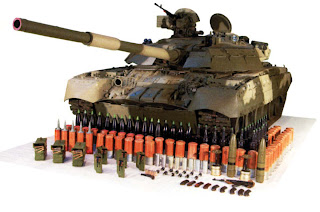What is it that makes the Marine Corps tankers dash into battle without tank ammo? Is it a logistical failure or just, you know, panache and derring-do?
It’s a regular happenstance. In 1958, during the Lebanon Crisis, the Sixth Fleet landed the BLT 2/2 and 3/6 off Beirut, eventually taking control of the airport, port and key bridges. The tanks went without ammunition–because it all was aboard an LSD that had broken down and was, at the time, bound for emergency repairs at Malta.
In 1983, M60A1 tanks clanked ashore at Grenada to help relive a besieged SEAL Team at the Governor’s residence. Government soldiers fled at the sound of armored vehicles, but…again, the tanks carried no main gun ammo.
The third instance was in Somalia, and we’ll let Ken Estes, author of Marines Under Armor, tell that tale:
“…When the time came to disarm the major rebel camps around Mogadishu, some containing M47 and T55 tanks, the rush was on to locate and stand up the few tanks that had been unloaded in desultory fashion on the piers. A tanker cadre composed of a captain, a staff NCO, and four crewmen, fleshed out by some selected nontanker personnel, manned four M1A1 tanks, with a fifth vehicle kept ready as a spare. The first operation put these vehicles into action armed with only 200 rounds of .50 caliber and 400 of 7.62 mm machine-gun ammunition. The 120mm tank ammunition had been reloaded to the MPS ships and some 13 days elapsed before two pallets of main gun ammunition arrived by air! On 10 January 1993 a “sort of” tank versus tank combat occurred as the scratch platoon battled six M47s using coax and .50 caliber fire. Amazingly, the rebels bailed out of their obsolete but lethal tanks, sensing that ranging machine guns had their mark and deadly 120mm rounds soon would follow…”
Sure, these tales are funny now, but the line between “a good story” and “tragedy” is sometimes pretty thin. And in cost-constrained environments, logistics is often the first item to be cut.
Without a firm and fixed focus on logistics, our “newly expeditionary” Marines could very easily land in something they can’t easily get out of. So, in the coming years, I hope those pesky Marines who ask annoying questions like “where is my ammo resupply?” or “how do we get gas and water ashore quickly?” and “how are we going to sustain ourselves longer than 48 hours?” get listened to–and that sufficient resources (and expertise) are available to address the USMC’s particular logistical requirements.


{ 3 comments… read them below or add one }
Amateurs talk strategy. Professionals talk logistics.
Logistics is the Rodney Dangerfield of warfare….it just can’t get no respect!
Incredible. I thought we had figured this out after Guadalcanal.